Five steps to create a social media content plan

It’s really important to be strategic about your social media, otherwise, you may find yourself spending time and resource on managing it but not knowing if it’s actually working. As we explained in our post on social media content planning, there are lots of benefits to creating a content plan. But how do you get started with your social media content plan?
We’re assuming you’ve already set your SMART goals but if not, here’s how to set SMART goals for social media. It’s very important to do this first.
Five steps to create a social media content plan for your organisation:
1. Decide what type of content you’ll create
Start thinking of the type of content that could resonate with your supporters. A good way to make your content stand out is to try different formats:
- Text
- Image
- Video
- GIFs
- Infographics
The good news is that you don’t have to have a big team to experiment with new content types as there are many free online tools to help you. To get started, analyse what you have posted before – say over the last 3 to 6 months – to see which content was the most successful and then explore what you can create next.
If you’ve found success in previous posts with image quotes, then this is an indication that you need to try something similar. However, you can also test new ideas by turning stories into short videos, for example.
Pick the right channel
The next step is to decide on the best content for each of your channels.
- Facebook is ideal for visual content, with images and videos bringing more engagement. Moreover, it may be a good idea to try out Facebook Live. It helps you stay close to your supporters, boosting your engagement while keeping them up-to-date with news, Q&As or events.
- Twitter also needs images or video to increase engagement. Consider adding relevant and appropriate GIFs to your tweets as a quick and easy way to interact with your supporters.
- LinkedIn is a great platform for sharing links to news stories, training, conferences or events and professional updates, while Instagram is all about great images and video that tell a story.
Decide on the frequency
How often should you post on each platform? There’s no magic answer to this question, but here’s some best practice guidance.
- Facebook: Facebook wants you to focus on engagement so every post should be interesting enough for your supporters to like, share, or comment. As a general rule, aim for 2-4 posts per week. It’s about quality, not quantity.
- Twitter: Twitter is all about real-time interaction. There’s no limit to the number of tweets that you can post daily, provided that you are adding value. Aim for 2-4 tweets a day, or if you have more creative ideas, you can schedule even more. At least a third of those tweets should be replying to people or having conversations.
- LinkedIn: LinkedIn is a great platform to build your professional network and to keep up to date with peers and colleagues. As a charity, post when you have an important announcement to share, relevant news, top tips or campaigns that are relevant to that audience. Aim for between 1-3 posts per week.
- Instagram: This platform requires high quality, creative images or video. If you regularly have access to great images or great ideas for video, then you can potentially aim for 1-2 weekly posts.
A good way to find out your ideal posting frequency is to experiment with your weekly schedule. If you start posting more frequently on a platform, but you don’t see an increase in engagement, then this means that you should focus on quality rather than quantity.
2. Get inspired by new ideas
Inspiration is a good thing, especially before planning your content. If you’d like to test new ideas and creatives, then have a look at other social profiles from organisations, influencers and brands outside of the sector. Take a look at the hashtag #CharityTuesday every week to find inspiration. You never know what might lead to a great idea for your own organisation.
Think of your upcoming campaigns, the events you’ll be running or the awareness days that are relevant to your organisation and come up with the content types that you’ll need to get people to stop scrolling and engage with your content.
One way to come up with new content ideas is to create content themes for the periods where you’re not running a specific campaign. For example, there are lots of opportunities throughout the year, from Dry January to International Women’s Day to Pride, that you can be part of.
You may also want to listen to what your supporters are talking about. They can help you plan your next campaign by paying attention to their needs and their concerns. Inspiration can be everywhere!
3. Plan your campaigns
Once you’ve found some inspiration, the next step is to create the actual copy for your posts. This stage is when you start thinking of your tone of voice, your message, the visuals or video and any other resources that you’ll need. This way you’re organised and have time to think strategically about the best channels to reach and engage your supporters.
It’s good to plan in advance as much detail of your campaign as possible, however not everything should be scheduled ahead of time.
Content you can plan in advance
You can organise your campaign’s content a few weeks before it actually goes live. This period gives you the flexibility to free up your time as you approach your campaign. You can either create the drafts to see an overview of what your campaign could look like or you can even go ahead and schedule them to be published.
Your social media profiles need to be kept active, whether you’re running a campaign or not. Promote your existing ‘evergreen’ content – such as information leaflets, stats, facts, case studies etc – to keep your social calendar filled throughout the year.
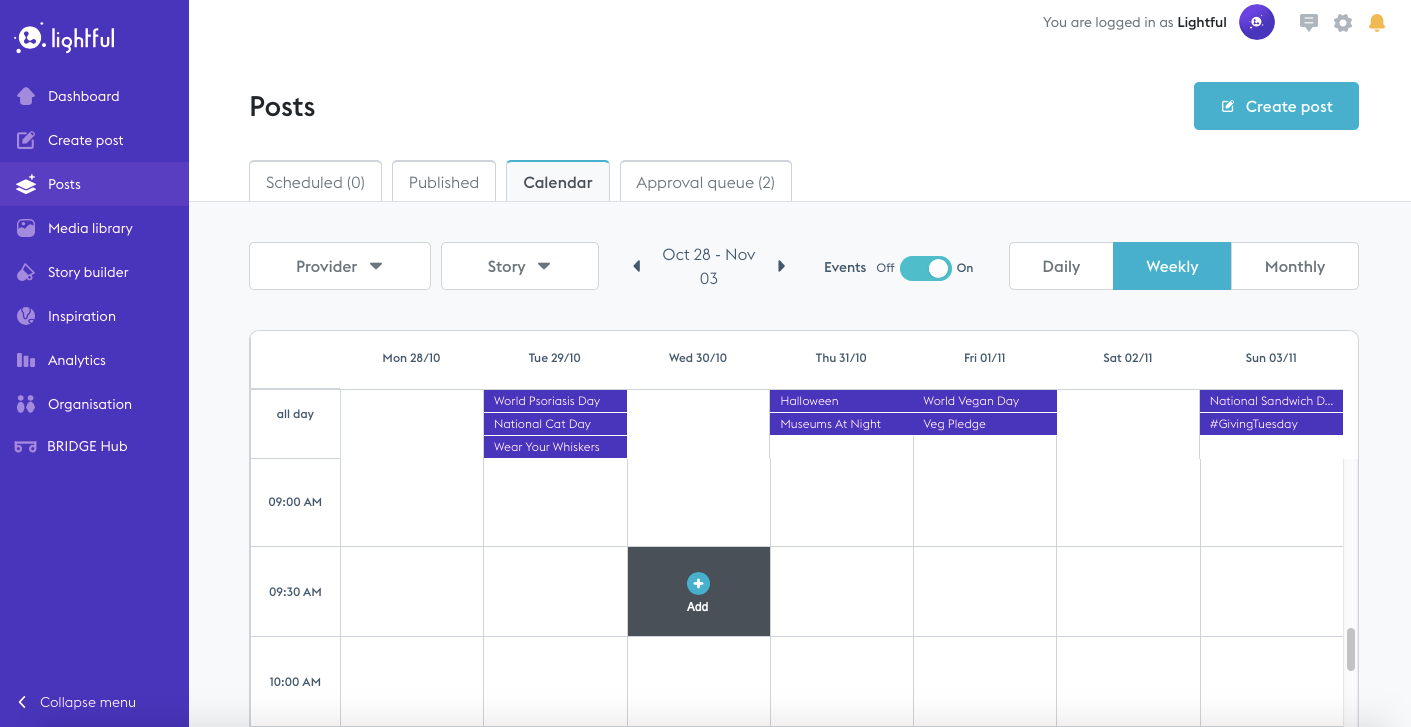
Content you can create in real time
Whilst it’s a good idea to save time by scheduling your content, there is still the need to engage with your supporters by replying to them or getting involved in real-time discussions. There will also be times when you will need to react and produce content, in real time, to trending topics that are relevant to your cause.
Tell your story
To make a connection between your cause and your supporters, tell authentic stories. Whether it’s the story of how your charity started, stories of the people you help or how you’re making an impact. Storytelling can make it easier for you to reach your goals of raising awareness, engagement, or securing donations.
A good way to make sure you’re using storytelling in social media is to create drafts of your posts so that you can see how they tell a story – from start to finish. You can go beyond a simple spreadsheet by trying our Story Builder in the Lightful Platform. It offers a quick and easy way to see the visual overview of your social posts across all channels for a particular campaign.
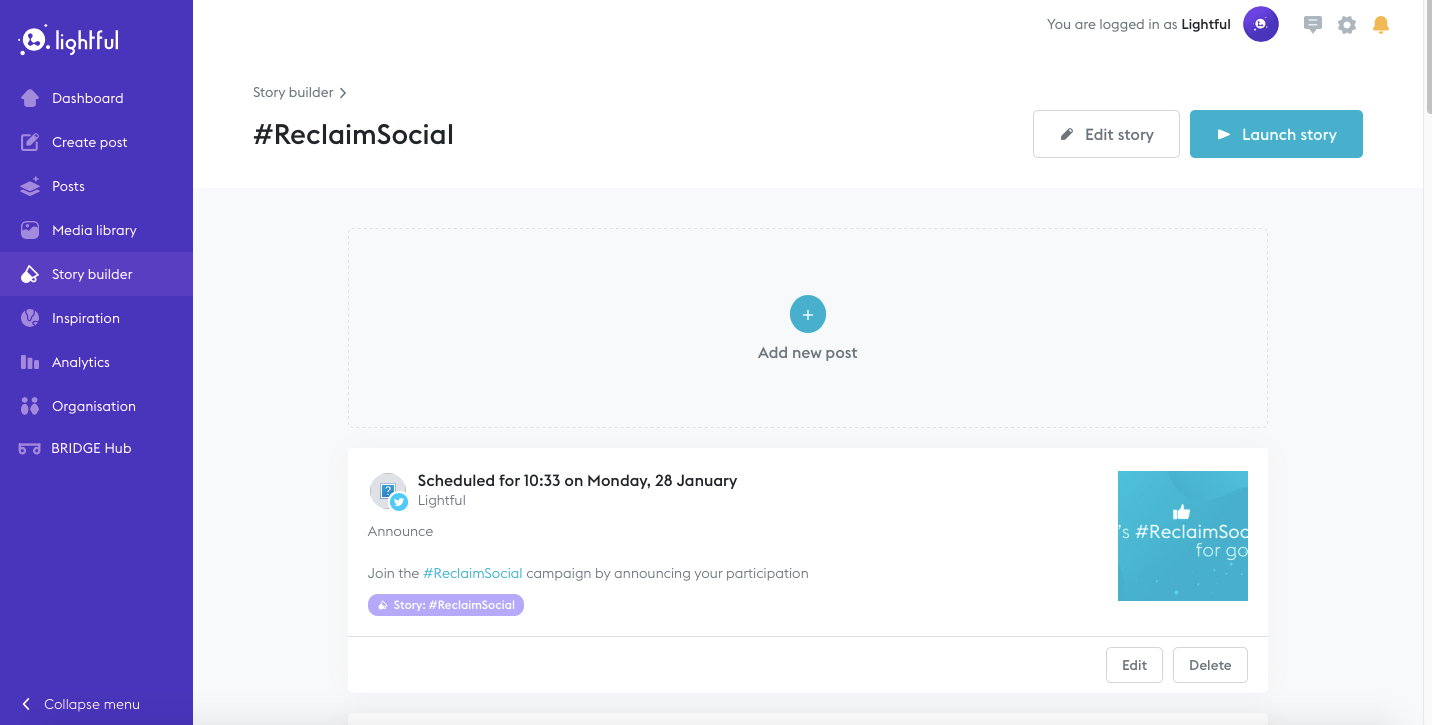
You can save them in a draft so that you can still adjust your content if needed when you get closer to your campaign launch. Having them all in one place means that you’ll still be able to see the whole picture of your campaign and how the narrative can develop.
The more organised you are through the pre-planning stage, the higher the chances of launching a successful campaign and reaching your goals.
4. Add the content to your calendar
Once you’ve decided on the content you need, it’s time to start scheduling it. It’s useful to have a bank of content ready for the days that you’ll be busy and have less time to spend on your platforms. That’s when a social content plan becomes handy. You can plan the next day, week, or month by scheduling your posts for each channel.

A good way to keep your social feed filled with content is to set up some time every week to schedule posts in advance. Whether it’s every Monday morning or towards the end of the week, it’s useful to get into the habit of doing this so that your social feeds are never empty.
Involve your colleagues
If you are part of a team running your organisation’s social accounts then you can turn the content creation process into a collaborative effort.
Our Lightful Platform allows you to involve multiple people in social media scheduling, whilst keeping editorial control through an approval process.
Plan, schedule and measure all your social media posts in one place!

Be proactive, but also reactive
Scheduling content can help you feel more organised with your social strategy, but you still need to be prepared to be flexible if an opportunity presents itself. Whether it’s a viral fundraiser that suddenly takes off or a comms crisis, you’ll need to revise your scheduled posts and edit them accordingly.
5. Analyse results
Once you’ve got your new social media plan in place, don’t forget to regularly review the performance of your content. Your metrics will help you discover your most successful posts and your best performing platforms, both in terms of traffic and engagement, so that you can keep on creating the kind of content that people want.
What should you measure?
Start by setting up SMART goals to define your objectives and how you’ll achieve them. These goals should guide you on what you want to measure.
For example, if you want to increase traffic to a specific landing page as part of a campaign, then you want to measure the number of clicks to that page and which channel drove the most traffic.

If you want to increase your organisation’s social presence, then you would focus on growing your number of followers by posting engaging content regularly on social media and by following relevant accounts so that they may follow you back.
You can measure:
- Best performing channels
- Best performing posts
- Best performing content types
The most common metrics rely on:
- Awareness: reach, impressions, clicks
- Growth of social accounts: followers
- Engagement: likes, comments, shares, reactions
- Fundraising objectives: increase in the number of donation and total donation amount

Once you start measuring the performance of your social posts, it should be easier to prove the value of social media to your colleagues, your manager, or your CEO.
How are you organising your social content? Any other tips you’d like to share with us? Tweet us @Lightful.
Latest articles
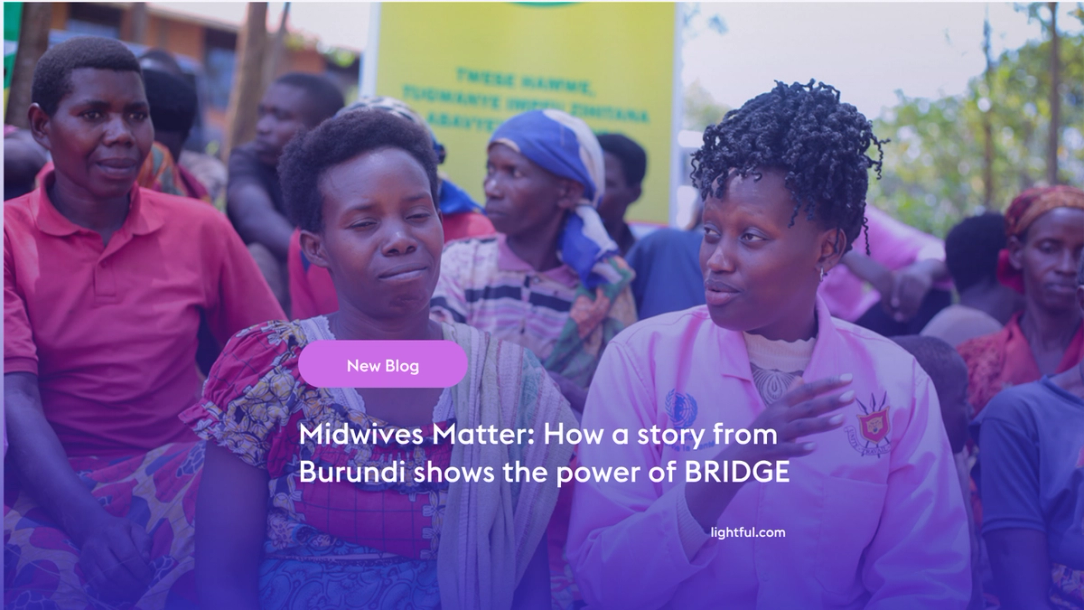
Over the past year, Lightful and the International Confederation of Midwives (ICM) have supported Midwives Associations across Africa, South Asia and the Eastern Mediterranean to build their digital confidence through our BRIDGE programme. These organisations were starting from very different places, but all shared the same goal: to use digital tools to strengthen their voice, raise their visibility and advocate for better outcomes for women and babies.
Related posts
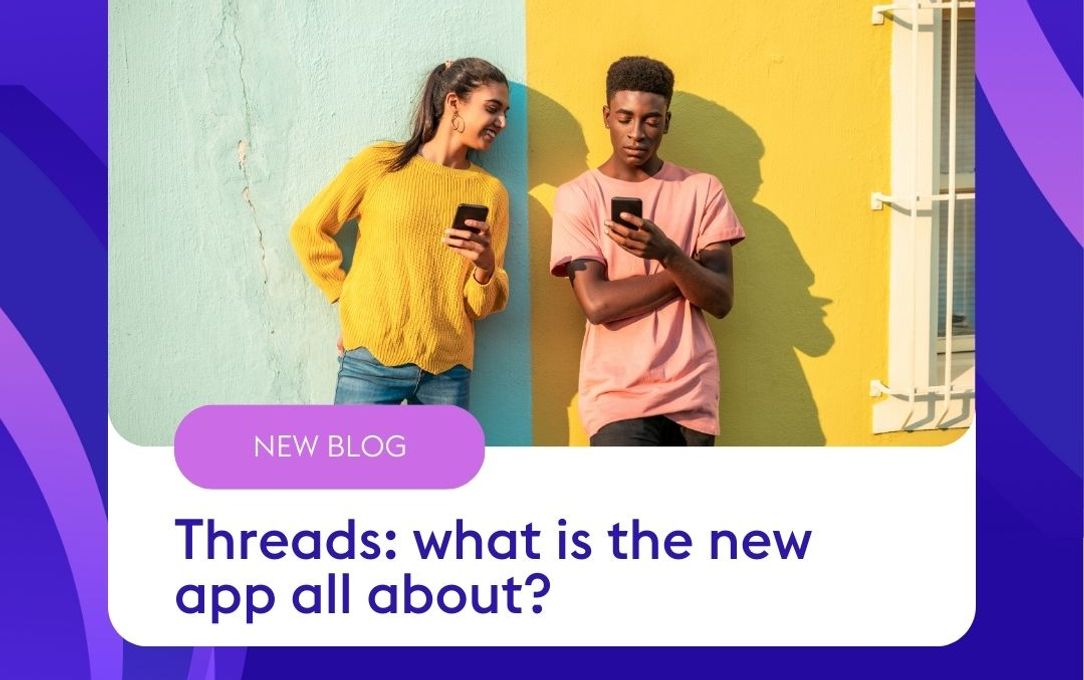
Meta’s latest app gained over 100 million users in just a few days, becoming one of the fastest growing apps ever. To put this into perspective, it took two months for Open AI’s ChatGPT to reach 100 million users, and we thought that was fast!
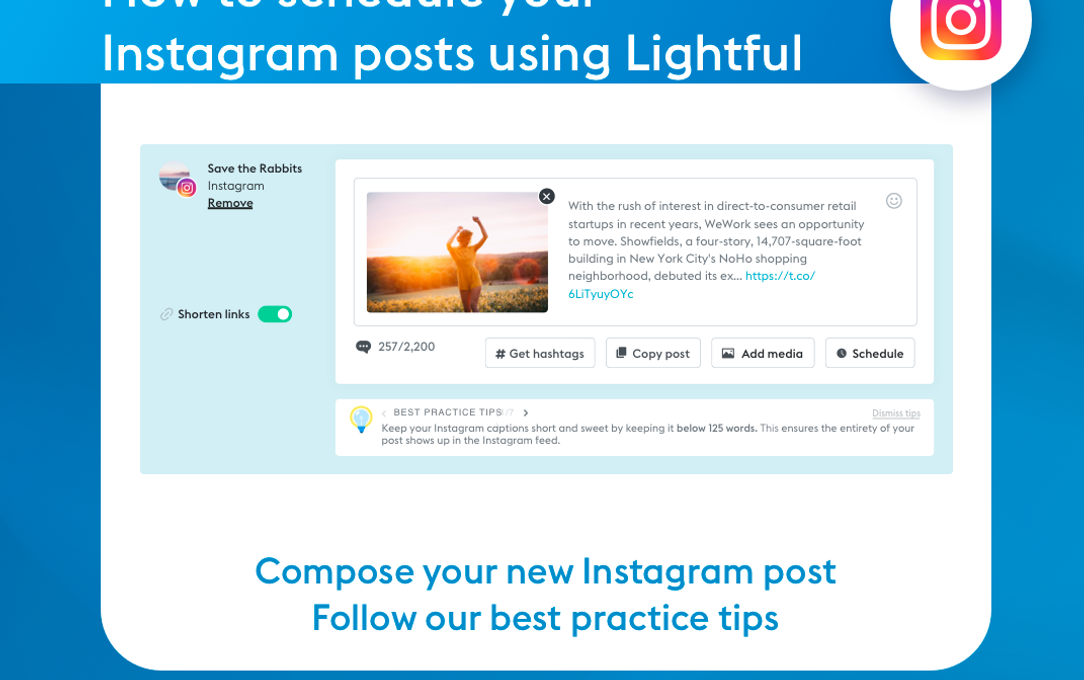
Instagram is a visual channel that helps you build an engaged community of people who are following your cause.
See who we help
Contact us
Want to learn more?
Email Jonathan and start a conversation






